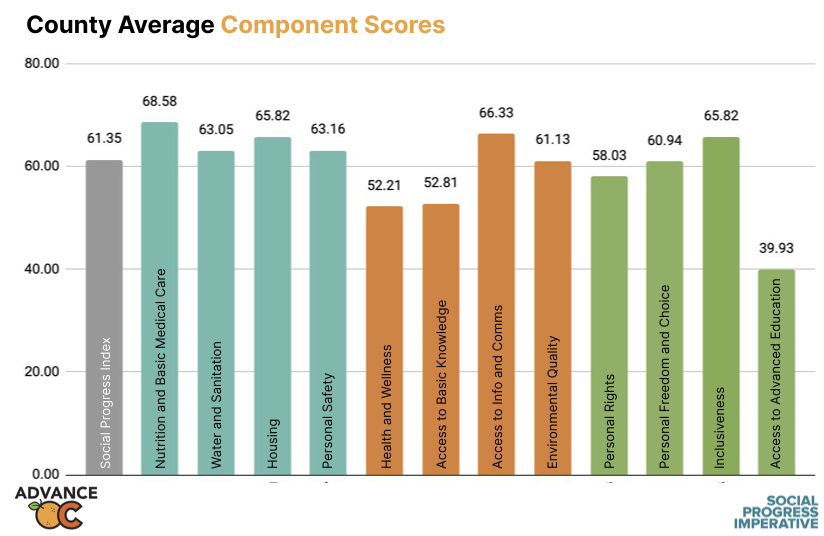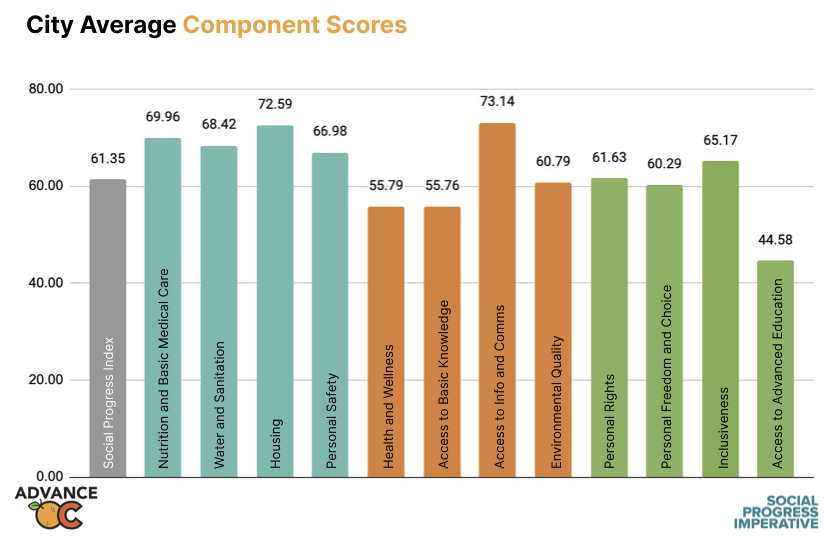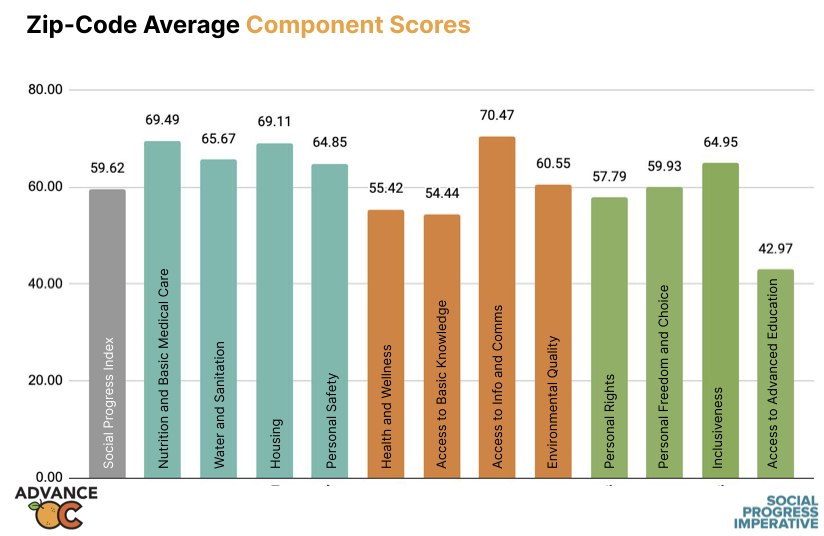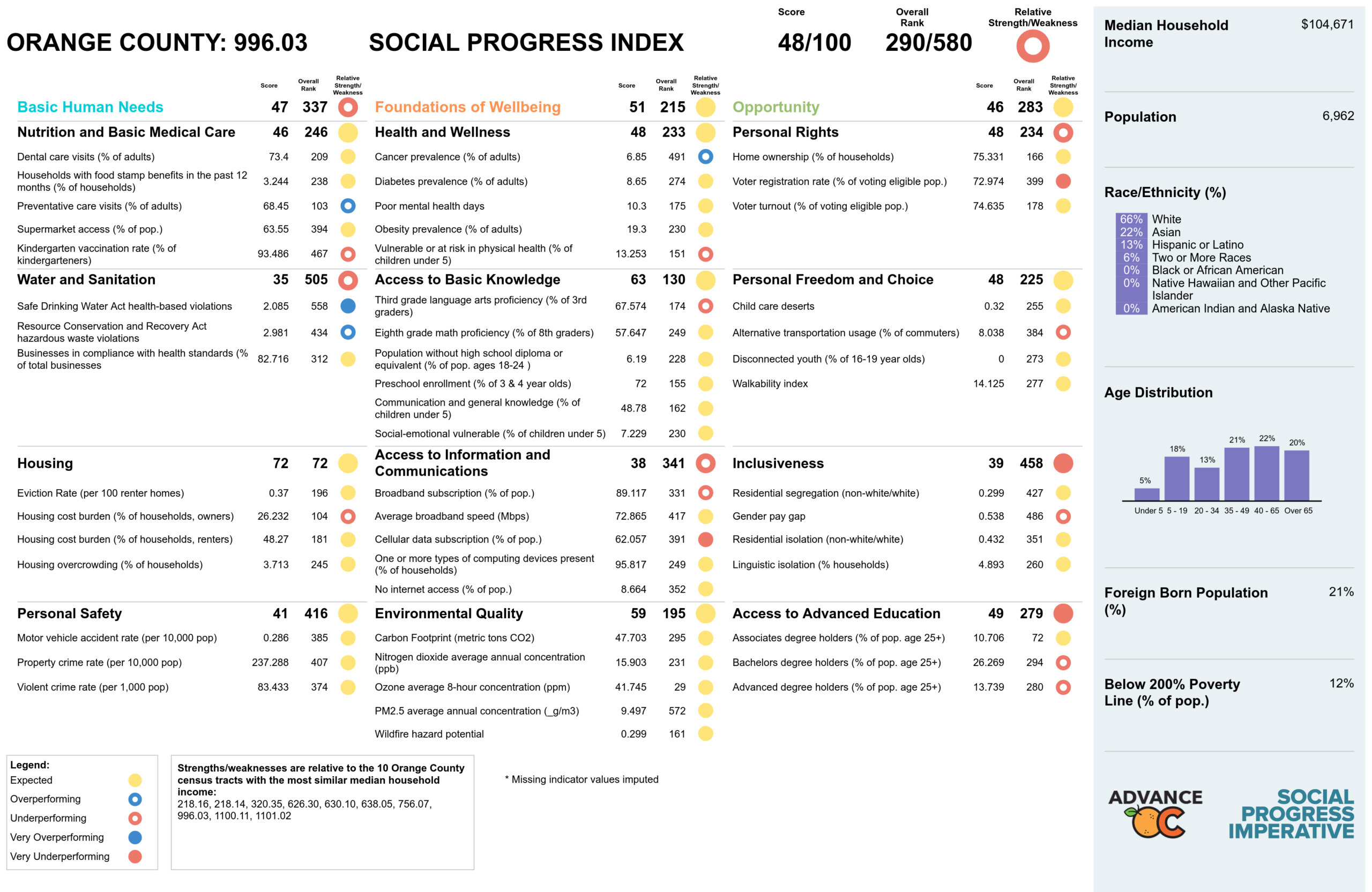Social Progress Index
The foundation of the Orange County Equity Map is a set of social and environmental metrics called the Social Progress Index. This index incorporates over 50 indicators that measure the health and wellness of a community.
Social Progress Index
The foundation of the Orange County Equity Map is a set of social and environmental metrics called the Social Progress Index. This index incorporates over 50 indicators that measure the health and wellness of a community.
Search by address, city, zip code, or neighborhood
The following dashboard allows you to search by address, city, zip code, or neighborhood census tract to view the corresponding Social Progress Index component scores.
Each map contains the respective population weighted average and different cities or zip codes are represented on every individual scale for users to benchmark.

How to Use the Index
To use the Index, type in your home address in the search toolbar and you will be taken to your neighborhood census tract. There, you can access your neighborhood scorecard by clicking on ‘See Scorecared’.
You can also view the scorecard of neighboring census tracts or any of the 580 census tracts in Orange County to compare and contrast. Every neighborhood census tract has a peer group of census tracts that has a similar median household income. Relative strengths and weaknesses is relative to this peer group.
How to Interpret the Data
As an Orange County resident
As a local elected official or policymaker
As an educator, healthcare provider, philanthropist
The Social Progress Index provides a baseline for community health and wellness, highlighting areas of need that require greater attention and community investment. Student and patient outcomes are strongly influenced by social and environmental factors. These social determinants are structural in nature and require partnership between community stakeholders and government agencies to address.
Social Progress Index: Orange County
Basic Human Needs
Nutrition and Basic Medical Care
- Dental care visits (% of adults)
- Households with food stamp benefits in the past 12 months (% of households)
- Preventative care visits (% of adults)
- Supermarket access (% of pop.)
- Kindergarten vaccination rate (% of kindergarteners)
Water and Sanitation
- Groundwater
- Hazardous waste
- Businesses in compliance with health standards (% of total businesses inspected)
Housing
- Housing cost burden (% of households, owners)
- Housing cost burden (% of households, renters)
- Housing overcrowding (% of households)
- Rental Assistance Priority Index
Personal Safety
- Motor vehicle accident rate (per 1,000 pop)
- Property crime rate (per 10,000 pop)
- Violent crime rate (per 1,000 pop)
Foundations of Wellbeing
Health and Wellness
- Cancer prevalence (% of adults)
- Diabetes prevalence (% of adults)
- Poor mental health days
- Obesity prevalence (% of adults)
- Vulnerable or at risk in physical health (% of children under 5)
Access to Basic Knowledge
- Third grade language arts proficiency (% of 3rd graders)
- Eighth grade math proficiency (% of 8th graders)
- Population without high school diploma or equivalent (% of pop. ages 18-24 )
- Preschool enrollment (% of 3 & 4 year olds)
- Communication and general knowledge (% of children under 5)
- Social-emotional vulnerable (% of children under 5)
Access to Info and Comms
- Broadband subscription (% of pop.)
- Average broadband speed (Mbps)
- Cellular data subscription (% of pop.)
- One or more types of computing devices present (% of households)
- No internet access (% of pop.)
Environmental Quality
- Nitrogen dioxide averge annual concentration (ppb)
- Ozone average 8-hour concentration (ppm)
- PM2.5 average annual concentration (_g/m3)
- Wildfire hazard potential
Opportunity
Personal Rights
- Home ownership (% of households)
- Voter registration rate (% of voting eligible pop.)
- Voter turnout (% of voting eligible pop.)
Personal Freedom and Choice
- Child care deserts
- Alternative transportation usage (% of commuters)
- Disconnected youth (% of 16-19 year olds)
- Walkability index
Inclusiveness
- Residential segregation (non-white/white)
- Gender pay gap
- Residential isolation (non-white/white)
- Linguistic isolation (% households)
Access to Advanced Education
- Associates degree holders (% of pop. age 25+)
- Bachelors degree holders (% of pop. age 25+)
- Advanced degree holders (% of pop. age 25+)
Underlying Sources of Data Used
What are the underlying sources of data used to create the Social Progress Index?
Data sources for the 50 indicators are detailed below. The SPI will be updated annually to reflect the most recent datasets available. It is our preference to use data from local agencies working in our community. It is ideal to use data streams that are disaggregated.

What was the Methodology used to create the Index?
The Social Progress Index is distinct from other wellbeing indexes in its measurement of social progress directly, independent of economic development, in a way that is both holistic and rigorous. Unlike many other quality of life measures, the Social Progress Index also captures whether societies are free, inclusive and protect the rights of individuals and minority groups.
Based on its four core principles, the Social Progress Index is designed to uniquely measure quality of life clearly and directly.
- Actionable: The index supports granular analysis of specific areas of strength and weakness, allowing change makers to identify and act upon the most pressing issues in their societies.
- Relevant to all communities: By measuring all aspects of social progress, from basic needs like shelter and nutrition to longer term goals like rights and freedoms, the index provides relevant insights to developing countries and advanced economies alike.
- Exclusive of social and environmental factors: By excluding economic measures from the index, we can, for the first time, compare a community’s social and environmental progress with its economic development and disentangle the relationship between them.
- Focus on outcomes not inputs: The index measures the outcomes that matter to the lives of real people. For example, we focus on the health and wellness achieved by a society, not how much is spent on healthcare. More information can be found here.
